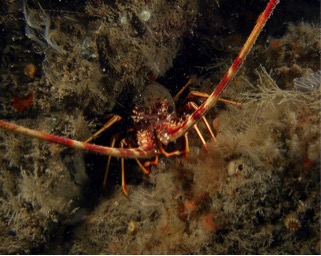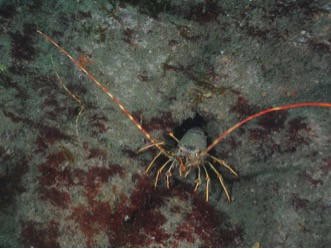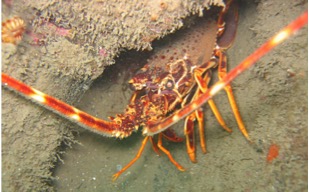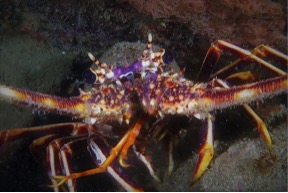Waters around the Lizard appear to be playing an important role in the recovery of an iconic crustacean from a population crash that threatened it with near-extinction in the 70’s and 80’s.
 Crawfish under a rock crevice. Credit: Natural England
Crawfish under a rock crevice. Credit: Natural England
Crawfish are a warm water species that are at the northern limit of their distribution in British waters. Although they may appear to resemble the more familiar Lobster, in fact the two are not that closely related. Unlike lobster, crawfish are golden-orange in colour and are covered in spines. They lack the familiar large claws of the lobster, instead being equipped with spikey front legs and long antennae. These beautiful crustaceans were once far more common around our shores, having been brought almost to extinction in the UK due to extensive overfishing by potting, scuba diving and netting in the 1970’s and ‘80s. Crawfish are identified as in need of protection, and are a Species of Principal Importance under the Natural Environment and Rural Communities Act 2006.
Crawfish are long-lived, mobile animals, that can grow up to 60cm in length and are known to migrate large distances over the seabed. They are typically found occupying rock ledges and crevices at depths beyond 15m. They regularly live to at least 15 years of age, and some individuals have been known to live much longer.

Crawfish: Dr. Keith Hiscock
Crawfish mate in the summer, and females carry the fertilised eggs externally for between 6-10 months. Females carrying eggs (known as ‘berried hens’) can be found in Cornish waters, but more commonly they will move to deeper waters offshore to overwinter while the embryos mature. Larvae are also carried into Cornish waters by warm ocean currents, so populations here may depend in part on the health of stocks in the Bay of Biscay and the coast of Spain.
Since 2015 recreational scuba divers in the south-west have been recording a veritable population ‘explosion’ of these marvellous creatures. The waters of the Lizard Special Area of Conservation (SAC) and the Manacles Marine Conservation Zone (MCZ) seem to be playing an important role in their recovery, due to vast rocky reefs that provide an ideal habitat for the species. Over the summer, divers at certain sites around the Lizard have been reporting sightings of crawfish from virtually every dive undertaken. A series of scientific survey dives have also confirmed this increasing population, and particularly encouraging are reports that show juveniles present as a high proportion of the total animals encountered.

Crawfish: Carolyn Waddell
Whilst the recovery of the crawfish population around the Lizard (and in Cornish waters more widely) is of course very good news, it does highlight a need to ensure the species is given adequate protection.
Currently, there are no Total Allowable Catch (TAC) limits or quotas applied to crawfish, though under UK-wide legislation the landing of berried females is prohibited. Earlier in 2018 the Channel Island of Sark became the first place in the British Isles to fully protect crawfish within the island’s three-mile territorial limit. Closer to home, the Cornwall Inshore Fisheries and Conservation Authority (CIFCA) have a minimum landing size of 110mm carapace length, and commercial fishermen must have a permit and submit monthly returns on catch statistics and fishing effort. Measures like these are crucial to help ensure the long-term sustainability of species in our waters.
The marine environment is incredibly complex, and in truth we may never fully understand the combination of factors that have driven the recent recovery of crawfish across the south-west. There is one thing we can be sure of though, and that is that the productive waters around the Lizard seem to be playing an important role in this recovery. The task now is to ensure these iconic creatures are back to stay.

Crawfish: John Yarrow/Seasearch Cornwall
Published: Dec 2018
Author: Carolyn Waddell (Marine Lead Adviser, West Cornwall)
